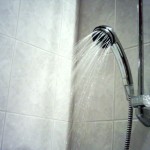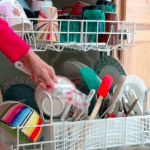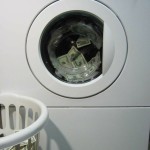Water Efficient Appliances – WaterSense 
The City of Santa Fe has partnered with the U.S. Environmental Protection Agency (EPA) to bring to you WaterSense, a national program that offers people a simple way to make product choices that use less water and perform as well or better than your existing products. WaterSense-labeled products and services offer equivalent or superior performance and purchasing WaterSense labeled products can help you protect the environment and help you save money on utility bills. To learn more, click here.
 In the Bathroom
In the Bathroom
- Save the baths for special occasions. The average bath uses 30-50 gallons of water, while a shower uses about 15 – and even less with a low-flow showerhead.
- Take short showers and install a cut-off valve, or turn the water off while washing and back on again to rinse.
- Install a high-efficiency showerhead and faucet aerators. For around $10 to $20, the average homeowner can install high-efficiency showerheads, replace faucet aerators and repair dripping faucets and leaking toilets.
- Reduce the level of the water being used in a bathtub by one or two inches if a shower is not available.
- Test toilets for leaks. Add a few drops of food coloring or a dye tablet to the water in the tank, but do not flush the toilet. Watch to see if the coloring appears in the bowl with a few minutes. If it does, the toilet has a silent leak that needs to be repaired.
- Never use the toilet to dispose of cleansing tissues, cigarette butts or other trash. This wastes a great deal of water and also places an unnecessary load on the sewage treatment plant or septic tank.
- Learn to repair faucets so that drips can be corrected promptly. It is easy to do, costs very little and can mean a substantial savings in plumbing and water bills.
- Do not use hot water when cold will do. Water and energy can be saved by washing hands with soap and cold water. Hot water should be added only when hands are especially dirty.
- When brushing teeth, turn the water off until it is time to rinse.
- Do not let the water run when washing hands. Water should be turned off while washing and scrubbing and be turned on again to rinse. A cut-off valve may be installed on the faucet.
- When shaving, fill the sink with hot water instead of letting the water run continuously.
- Install a high-efficiency toilet (HET, 1.28 gallons or less per flush), save 20 percent more water than a low-flush toilet (1.6 gallons per flush), and earn a City rebate. A WaterSense-labeled toilet fact sheet is available.
- Consider a water-free urinal, which looks and works like conventional urinals, except there is no flush. Water-free urinals do not require water to flush, and flush valves or other control hardware to operate are eliminated. No-flush urinals can be installed anywhere the conventional type would be used. The City offers rebates on high-efficiency toilets and water-free urinals.
 In the Kitchen
In the Kitchen
- Scrape the dishes clean instead of rinsing them before washing. There is no need to rinse unless they are heavily soiled.
- Use a pan of water (or place a stopper in the sink) for washing and rinsing pots, pans, dishes and cooking implements rather than turning on the water faucet each time a rinse is needed.
- Never run the dishwasher without a full load. This practice will save water, energy, detergent and money.
- Use the garbage disposal sparingly or start a compost pile.
- Keep a container of drinking water in the refrigerator. Running water from the tap until it is cool is wasteful.
- Use a small pan of cold water when cleaning vegetables rather than letting the water run over them.
- Use only a little water in the pot and put a lid on it for cooking most food. Not only does this method save water, but food is more nutritious since vitamins and minerals are not poured down the drain with the extra cooking water.
- Use a moisture meter to determine when house plants need water. More plants die from over-watering than from being dry.
 In the Laundry Room
In the Laundry Room
- Wash only a full load when using an automatic washing machine (32-59 gallons are required per load). Washing clothes is the second largest water user in most households with an estimated seven loads per week.
- Replace an old machine with a high-efficiency clothes washer; many use 14 gallons per load or less, which will earn you a rebate from the City, as well as saving laundry detergent, wear and tear on clothing, drying time, energy, money, and water. Your next clothes washer purchase will have an enormous effect on the amount of water you will use or save over the next 10 years.
- Whenever possible, use the lowest water-level setting for light or partial loads.
- Use cold water as often as possible to save energy and to conserve the hot water for uses that cold water cannot serve. (This is also better for clothing made of today’s synthetic fabrics.)
- Insulate all hot water pipes to reduce the delays (and wasted water) experienced while waiting for the water to become hot.
- Be sure the water heater thermostat is not set too high. Extremely hot settings waste water and energy because the water often has to be cooled with cold water before it can be used.
- Make sure the water connection to the clothes washer is tight. This is an easy place for a leak to hide.
